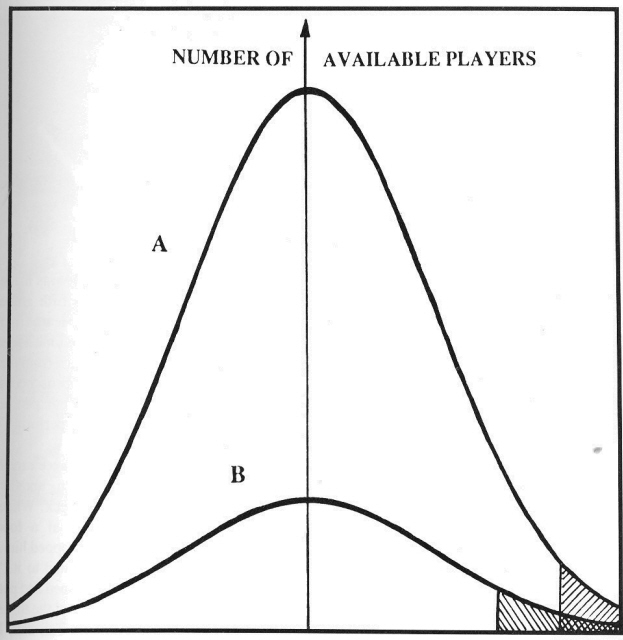
Average Level of Talent |
Page 15 Spring 1988
|
As
mentioned above, pitchers and batters will improve by roughly the same
amount; so the first conclusion is not incompatible with Gould's data
for a stable average batting average. The second conclusion is in
agreement with Gould's data on a shrinking standard deviation. At this
point, I return to the assumption that the number of major leaguers
has been constant with time. I realize that the number of major league
teams has increased since early baseball history (so the shaded areas
should not be equal), but if the number of available players increases
by a greater percentage than the number of major league baseball
teams, then both of the above-stated conclusions remain valid.
A
probable answer, or at least a partial answer, to an earlier
question is now
All
of these circumstances have led to improved talent. But what does
this have to do with juggling?
I
know some feelings are going to be hurt if I make negative comments
about the talent of present-day jugglers, but the conclusions I make
are not meant to belittle anyone. In the preceding paragraphs it is
shown that talent improves as the number of available players, or in
this case, jugglers increases. Without the graphs, most people know
this through intuition. So my claim is as follows:
Most
of today's well-known jugglers would be unknowns if juggling was as
popular as baseball. What is the percentage of people who become
involved in juggling? Although IJA memberships have increased
tremendously during recent years, there are many more kids running
around on baseball diamonds than kids juggling in backyards.
In my opinion there are many Anthony Gattos in this country. How can a kid know if he is good at juggling if he does not learn to juggle? And of those who have learned to juggle, how many of them juggle seriously?
The
greatest juggling potential in America is more than likely possessed
by someone who does not juggle. This person may live in a small
Wyoming town. He may be a shoeshine boy in Manhattan. He may be a
Detroit factory worker. On the other hand, she may be a
businesswoman living in the San Fernando Valley.
Who
knows where this juggler lives? Who knows where many great jugglers
live? There are probably numerous juggling stars from Walla Walla,
Washington to Kalamazoo. How can we
find these great jugglers? Only with a tremendous boost in the
popularity of juggling can such superior talent be revealed.
So
in the meantime, consider Albert Lucas to be the Ty Cobb of juggling
and not the Pete Rose.
(Paul
DeMoulin is a Ph.D. candidate at Purdue University in W. Lafayette.
Indiana.) |

Average Level of Talent |